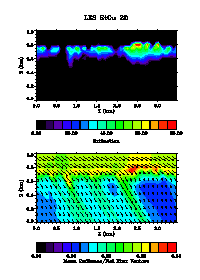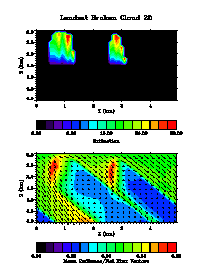 Broken:
Broken: 
The extinction field, mean radiance, and net flux vectors are shown for two 2D media. The mean radiance gives the local intensity of radiation, while the net fluxes show the bulk energy flows.
The first field is a 2D slice of a 3D marine stratocumulus cloud obtained from a Large Eddy Simulation. The second field is a 2D cloud field reconstructed from a Landsat image.
In both cases the solar zenith angle was 45 degrees, which explains the orientation of the net flux vectors above cloud top. Under the thicker regions in the stratocumulus cloud the mean radiance is lower and the net flux is closer to straight down. The broken cloud case shows much more cloud shadowing effects than the overcast boundary layer cloud case. The net flux vectors actually point upwards in the shadow of larger cumulus cloud, as the surface reflection adds to the radiation leaking sideways through the cloud.
The liquid water content (LWC) specified by the LES model was converted to a droplet size distribution by assuming a constant droplet concentration of 50 cm^-1 and an effective variance of 0.1. The resulting effective radius and LWC at each grid point are used to index into a Mie table to get the extinction, single scattering albedo, and phase function. P> A broadband solar calculation was done using the 6 band correlated k-distribution method of Fu and Liou (1992). The solar zenith angle is 60 degrees and the surface albedo is 6%. The angular resolution of SHDOM run was 8 angles in zenith and 16 in azimuth. Although the domain average heating profile is almost identical between the independent pixel approximation and 3D radiative transfer, the heating rate pattern differs significantly between 3D and IPA.
A poster from the International Radiation Symposium shows more SHDOM results for this LES cloud, including broadband and remote sensing calculations and analysis.
An image of the upwelling zenith radiance shows how the contrast decreases and there is some blurring of the surface as the optical depth increases. Cross sections at several optical depths show this more quantitatively.